A Breakdown of How Hard It Is to Access an Abortion in the U.S.

By:
Forty-three years after Roe v. Wade (1973), the landmark decision by the United States Supreme Court on the legality of abortions, it's no secret that abortion rights remain hotly challenged — especially on a state level. In 2015 alone, state legislators passed 57 different constraints on a women's right to choose, according to The New York Times.
How difficult is it to get an abortion in each state?
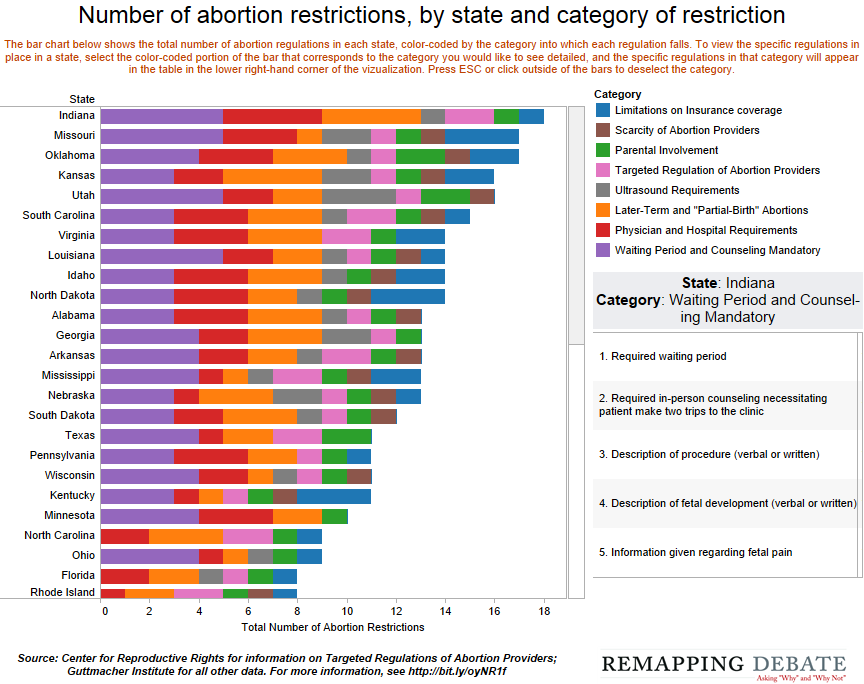 Remapping Debate - remappingdebate.org
Remapping Debate - remappingdebate.org
The above graphic by the Center for Reproductive Rights shows how many restrictions there are in each state broken up into categories like mandatory waiting periods, mandatory counseling, late-term abortions, parental consent, and other common restrictions.
According to the Guttmacher Institute, as of January 2016, 19 states have laws prohibiting partial-birth abortions, 43 states prohibit abortions beyond the point of "fetal viability," 38 states require parental consent, 17 states require women to be given counseling, 28 states maintain waiting periods (usually between 24 and 72 hours), and 11 restrict coverage of abortions in private insurance plans, with the exception of endangerment to the mother's life.
In these states, the getting an abortion is particularly difficult.
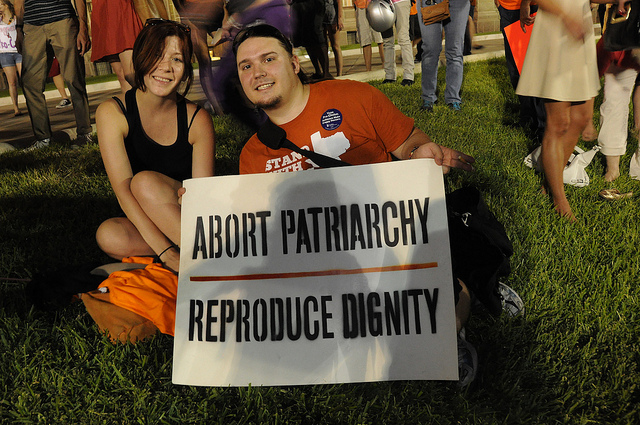 Ann Harkness/Flickr Creative Commons - flickr.com
Ann Harkness/Flickr Creative Commons - flickr.com
Indiana, Missouri, Utah, Louisiana, Oklahoma, Georgia, Arkansas, Mississippi, Texas, Ohio, and Minnesota all have notably high numbers of restrictions when it comes to waiting periods.
Research has found that waiting periods, which tend to be required along with state-mandated counseling sessions to dissuade women from going through with the procedure, increase the number of abortions obtained out of state and at later times. Rather than lower rates of abortions, waiting periods tend to merely make getting an abortion more difficult and potentially dangerous. State-mandated counseling sessions also tend to be ideologically driven and provide women with misleading information.
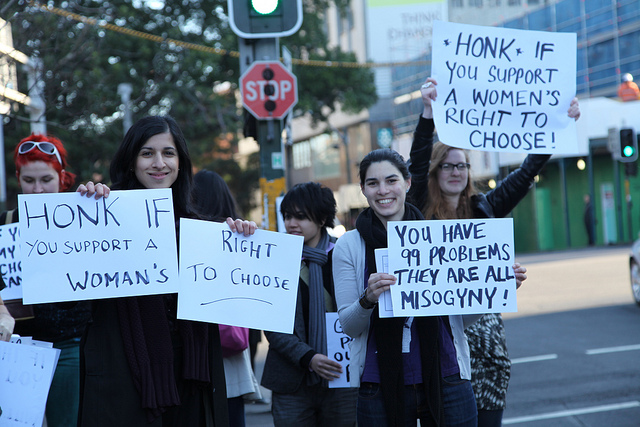 Kate Ausburn/Flickr Creative Commons - flickr.com
Kate Ausburn/Flickr Creative Commons - flickr.com
These states, along with Idaho, North Carolina, South Carolina, Virginia, Alabama, and Pennsylvania, also have more restrictions when it comes to physician and hospital requirements.
Indiana and Kansas both have four restrictions on late-term abortions, while Oklahoma, Idaho, Alabama, Georgia, Nebraska, South Dakota, and North Carolina each have three.
Missouri, North Dakota, and Kentucky seem to place the most limits on private insurance coverage, limiting coverage of abortions to when medically necessary for women.
In these states, getting an abortion is moderate.
Florida, Rhode Island, Arizona, Michigan, West Virginia, Alaska, Illinois, Massachusetts, and Tennessee all have a moderate amount of restrictions, although it's worth noting that Michigan, Alaska, and West Virginia all maintain restrictions related to waiting periods, and all of these states except Illinois have parental consent restrictions.
In these states, the process is simpler.
Nevada, Montana, Wyoming, Connecticut, Colorado, Iowa, Delaware, New York, New Jersey, California, Maryland, Maine, Washington, New Mexico, Hawaii, D.C., Oregon, and Vermont have minimal restrictions, with none except Colorado implementing waiting period-related restrictions. Parental consent restrictions are still enforced in Wyoming, Colorado, Iowa, Delaware, Maryland, and late-term restrictions exist in nearly all of these states except Vermont and Oregon. However, these states have dramatically fewer restrictions than the others.
Abortion in America, before and after Roe v. Wade.
While the Roe v. Wade decision by no means served as a conclusive end to the cultural stigmas and political war around abortions, prior to the ruling, many states either banned or placed severe restrictions on the procedure. This led to high rates of "back-alley" abortions and attempted self-terminations among impoverished, predominantly immigrant and nonwhite women across the country. Many either died or seriously injured themselves attempting to terminate their pregnancies.
In short, even before Roe v. Wade, women were having abortions because of limited access to contraceptives and lack of resources to care for more children. However, abortions were simply taking place outside of the law in unsafe environments.
Roe v. Wade first emerged when, in 1970, Linda Coffee and Sarah Weddington, Graduate students of the University of Texas Law School, sued Henry Wade, the Dallas Country District Attorney, on behalf of Norma L. McCorvey, called "Jane Roe." Roe claimed that a Texas law criminalizing all abortions except those endangering a pregnant woman's life violated Roe's constitutional rights.
The U.S. Supreme Court reviewed the case through 1971 and 1972, and in 1973 the court ruled 7-2 that the Texas statute violated Roe's constitutional right to privacy. The decision cited the Constitution's First, Fourth, Ninth, and 14th Amendments on individuals' "zones of privacy," and previous rulings identifying "marriage, contraception, and child rearing" as "zones of privacy." But the Supreme Court also ruled that ultimately, the state is allowed to regulate abortions to protect the mother.
In the decades following Roe v. Wade, plenty of significant decisions regarding abortion rights have been made by the Supreme Court, like the stages a woman can legally obtain an abortion, the affordability of abortions, age restrictions and consent from pregnant women's parents or husbands (yes, really), and the accessibility of clinics. And today, many lawmakers continue to lead a divisive political war against reproductive rights.
This restriction on a woman's right to choose is largely carried out through passing tricky legislation that unnecessarily complicates the process of obtaining a medically safe abortion.
"The fact is, first-trimester abortions, which account for the overwhelming majority of all abortions, are already among the safest medical procedures available," the New York Times Editorial Board wrote in November, when the Supreme Court announced its 2016 schedule. It continued:
"What endangers women’s health is when legal abortions are made harder or impossible to obtain, because women will be forced to wait until later in their pregnancies, when there is a higher risk of complications, or they will turn to illegal and dangerous methods."
Abortion rights are about to return to the Supreme Court.
In recent years, restricting access to abortion clinics has been the most widely used method among anti-choice lawmakers to discourage abortions. And in its first major abortion case in almost 10 years, which is slated for March 2016, the Supreme Court will begin reviewing Whole Women's Health v. Cole, a case challenging a Texas law that sets regulations on clinics, which have resulted in half of the state's clinics closing since 2013.
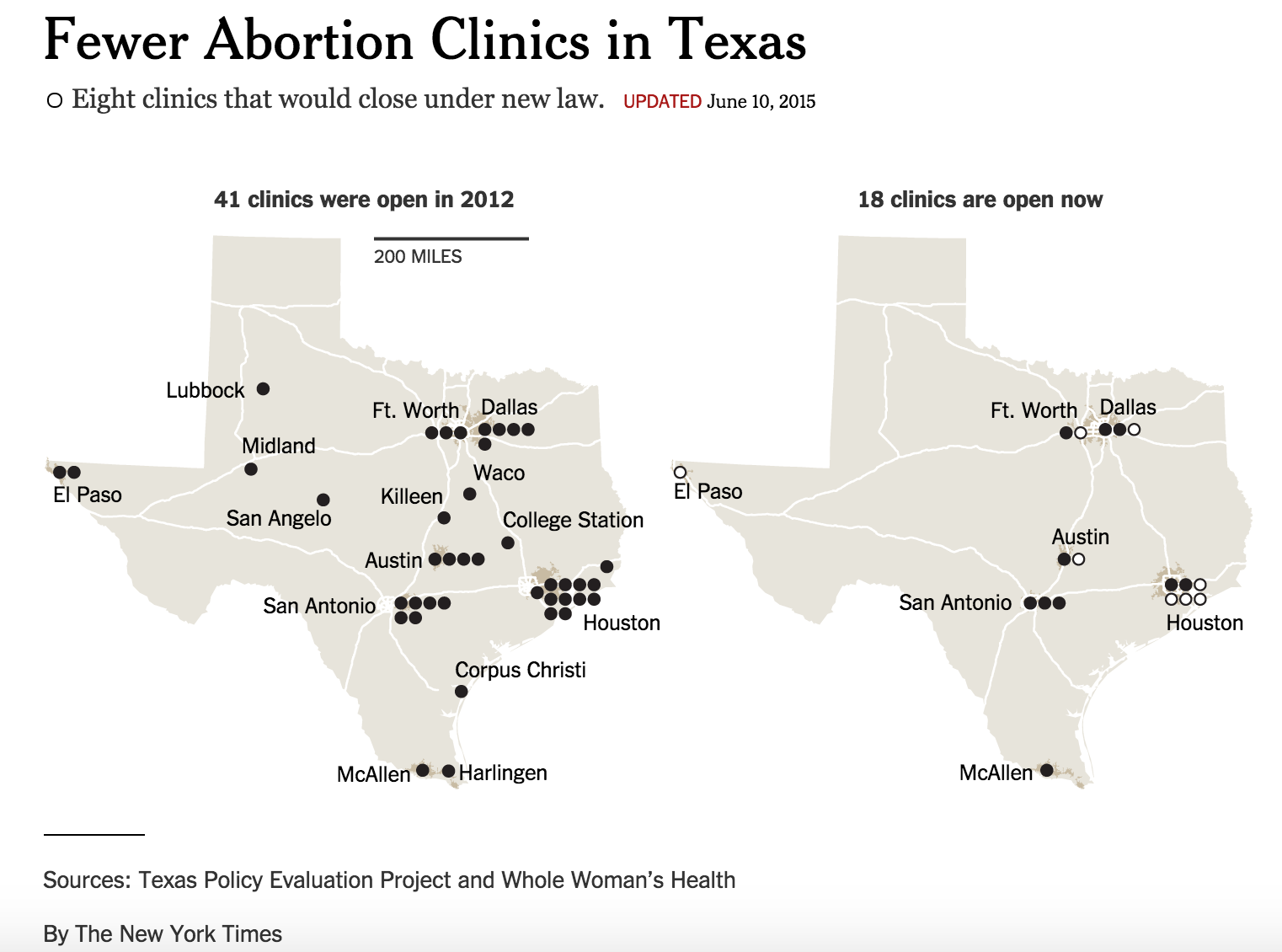 The New York Times - nytimes.com
The New York Times - nytimes.com
Texas' House Bill 2 nearly requires abortion clinics to become "mini-emergency rooms," according to Vox, which must be able to function as ambulatory surgical centers with hospital admitting privileges in order to remain open. The reforms that the bill requires from clinics would cost more than $1 million, abortion providers say. These high costs are meant to minimize complications that are already extremely low-risk.
This case could have tremendous implications for poor women above any other demographic, as their ability to obtain abortions depends largely on access to the very clinics that are under attack.
It's worth noting that women who discussed their experiences with abortion in briefs provided for the Supreme Court earlier this month made history by including their real names, indicating progress in our cultural attitudes about abortion since Roe v. Wade.
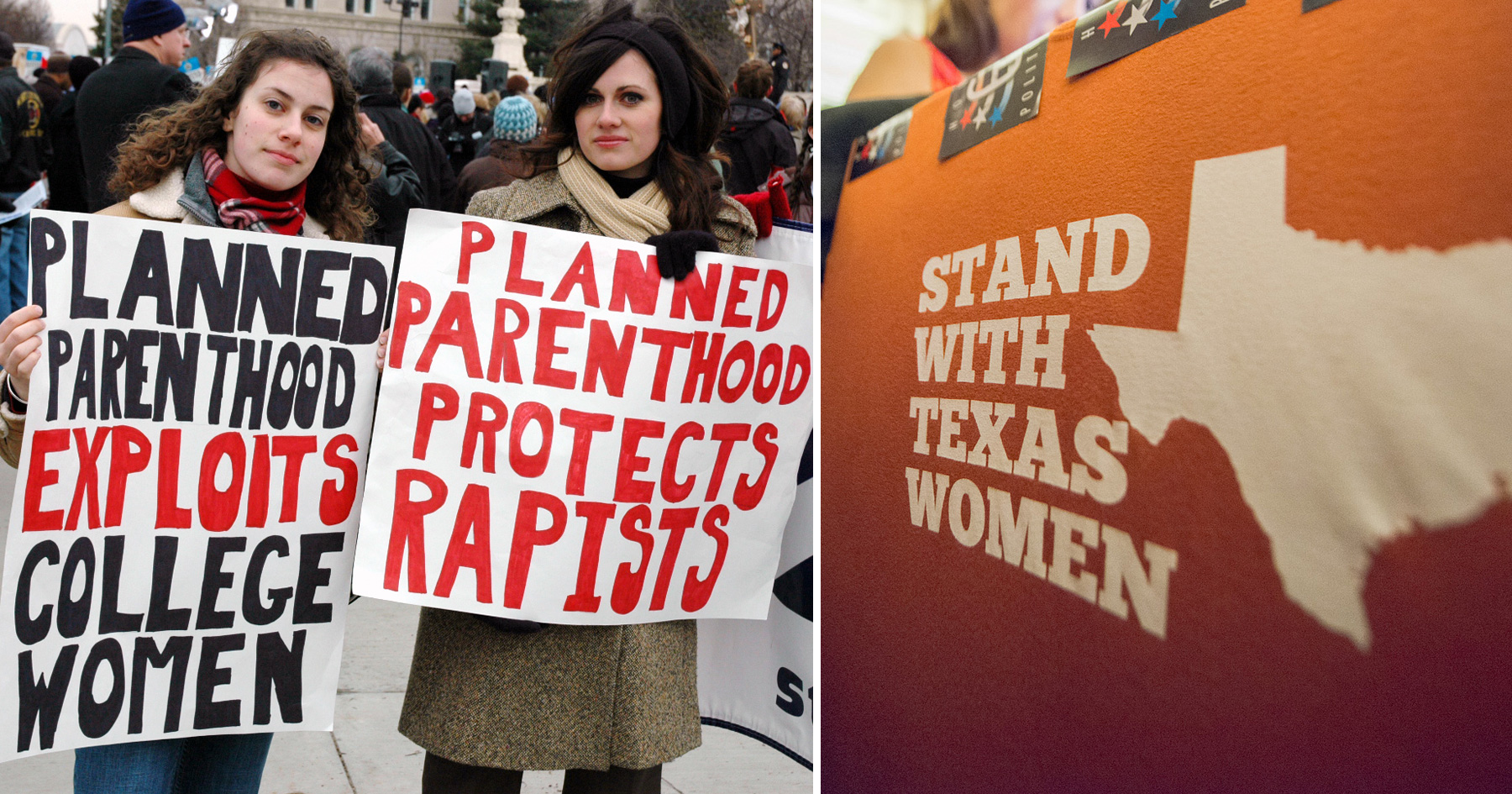 Flickr/American Life League, Flickr/Do512 - flic.kr
Flickr/American Life League, Flickr/Do512 - flic.kr
As SCOTUS prepares to review Whole Women's Health v. Cole, other important laws about abortion are also being challenged. Democratic presidential candidate Hillary Clinton recently spoke out against the Hyde amendment, instated 40 years ago by a conservative Supreme Court, which bars use of certain federal funds to pay for abortion unless the pregnancy arises from incest, rape, or to save the life of the mother.
Cultural attitudes about abortion remain complicated.
Earlier this month, Debbie Wasserman Schultz, chairwoman of the Democratic National Committee, called out what she identified as "complacency" about abortion rights among young women. And while the Schultz's characterization of the thousands of young women initiating pro-choice campus organizing and vocally supporting pro-choice social media campaigns as "complacent" wasn't quite accurate, in some ways, ambivalence toward abortion has been on the rise lately.
Decades after Roe v. Wade, with the political dialogue surrounding abortion rights simplified to whether one is "pro-life" or "pro-choice" and quietly accepted assumptions about the stances of the Republican and Democratic parties, politicians have been focused more on discussing other issues over reproductive rights.
National statistics indicate that as taboo as discussing abortion seems to be, it's a surprisingly common procedure: One in three women will have an abortion, and 95 percent won't regret their decision.
Since last year, with the spread of heavily edited and misleading footage targeting Planned Parenthood, silence and ambivalence on reproductive rights could be destructive.
The rise of inflammatory rhetoric portraying abortion as murder and providers as murderers, higher rates of arson and intimidation on clinics, and even gun violence inspired by dangerous political rhetoric in 2015 indicate that four decades after Roe v. Wade, abortion rights remains a serious political issue.
